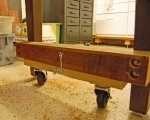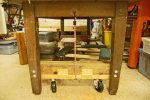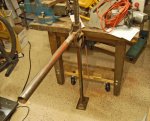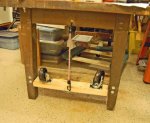Stuart Ablett
Member
- Messages
- 15,917
- Location
- Tokyo Japan
I have a friend here who is looking to make a real workbench, but it has to be moveable as he parks his van in his workshop.
I was looking to find an easy way to do this. I like the idea of two swivel casters mounted on a board of some sort that is hinged to ends of the work bench that flip up or down, so when moveable, the wheels touch the ground, but when in use the four legs sit right on the ground. He will use this bench for hand tool work, including a lot of hand planing, so it has to be solid and stable, no locking caster kind of thing.
Anyone have pics or a website with such a thing? On a quick search, I could not find much...
Cheers!
I was looking to find an easy way to do this. I like the idea of two swivel casters mounted on a board of some sort that is hinged to ends of the work bench that flip up or down, so when moveable, the wheels touch the ground, but when in use the four legs sit right on the ground. He will use this bench for hand tool work, including a lot of hand planing, so it has to be solid and stable, no locking caster kind of thing.
Anyone have pics or a website with such a thing? On a quick search, I could not find much...

Cheers!










